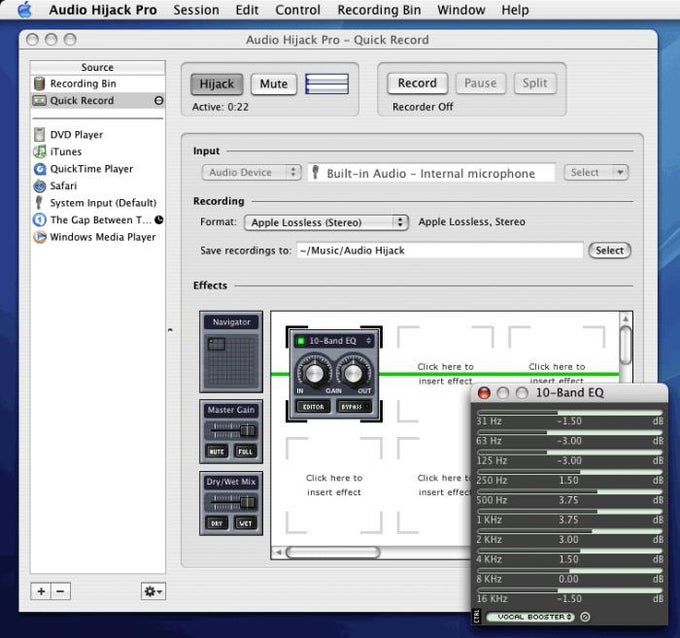Threephase Circuits
Motor Equivalent Circuits (Steinmetz) As mentioned above, when the stator windings are connected to the AC supply, the voltage is induced in the rotor windings. Basically, the working principle is the same as a transformer, i.e., the inductive motor is a transformer in which the secondary side rotates. Aug 04, 2016 Video Lecture on Need of Three Phase Supply of Chapter Three Phase Circuits of Subject Basic Electrical Engineering for First-Year Engineering Students.
As described by the company, 'if it can be heard on Mac OS X, Audio Hijack can record it.' Rogue Amoeba notes that the last version of Nicecast, version 1.11.13, works as expected on macOS High Sierra and earlier, but may experience compatibility issues with macOS Mojave. Rogue Amoeba today announced the launch of Audio Hijack 3 for Mac, which allows users to record audio from any source, including Skype, Safari, or hardware inputs like microphones.  And, as a 32-bit app, Nicecast will eventually not work at all once a future macOS release.
And, as a 32-bit app, Nicecast will eventually not work at all once a future macOS release.
A three-phase circuit is an electrical distribution method that uses three alternating currents to supply power. This type of is the most widely used in the world for transferring power from generating systems to electrical supply grids. A three-phase circuit is also commonly used on large motors, pumps, and other pieces of mechanical equipment. Most households receive electricity in the form of single-phase circuits, though some may have special three-phase circuit breakers installed for appliances such as washing machines or stoves.  To understand how a three-phase circuit works, it is helpful to understand how power is generated.
To understand how a three-phase circuit works, it is helpful to understand how power is generated.
Power plants use fuel sources such as oil or gas to power large-scale generators. These generators rely on a revolving to produce waves of electrical current. For single-phase power, picture each full rotation of the revolving field creating a single wave of electrical current. That is, for each 360-degree turn, one wave of electrical current is set in motion and distributed through the power grid. To produce three-phase power, three separate waves of current are generated for each revolution of the magnetic field.
For every 120 degrees of revolution, a wave is released, for a total of three waves per 360-degree turn. These three waves travel together throughout the power grid, and will stay in a set unless separated by mechanical means. The three waves produce an alternating current, meaning they peak at different times.
Unlike a single-phase circuit, a three-phase system will always produce a continuous level of electrical current because there will always be one wave in peak position. As three-phase power reaches the circuits in a building, it creates 208 Volts of electricity. When this three-phase power reaches a house, it first passes through a transformer to transform it to single-phase power, which produces 120 Volts of electricity. A standard 120-Volt household appliance can be plugged into a three-phase circuit, but will operate less efficiently than if it were plugged into a single-phase circuit. Three-phase power distribution is not only efficient, but offers superior performance for most applications.
It provides a smooth and even electrical supply so that motors and equipment can operate more effectively. This smooth electrical supply leads to less vibration and wear for mechanical equipment, and also helps to extend the life of these devices. Three-phase circuits are also able to supply larger quantities of power than single-phase systems, making it particularly beneficial for large-scale applications.
Three Phase Circuits Theory

04/23/98 EDN Design Ideas: NOTE: File contains multiple circuits scroll to find this circuit. Have you ever wondered which way a blower motor is going to turn when you plug it into anor socket, or have you ever inherited task of modifying three-phase wiring in your plant?
__ Circuit Design by Hugh Adams, Fort Walton Beach, FL - 02/16/98 EDN Design Ideas: (File contains several circuits, scroll to find this one) The circuit in Figure 1 allows you to record process variables (4 to 20 mA, 0 to 10V dc]on a three-phase power monitor designed to record only ac waveforms. Many of se recorders have a seventh channel, normally used for recording neutral current, which you can use as a process-variable input. The circuit operates __ Circuit Design by Warren Jochem, Research Triangle Institute, Research Triangle Park, NC - 12/17/98 EDN Design Ideas: Measuring line-to-line voltages in a delta-connected three-phase system can present special problems.
Because all three lines may be floating several hundred volts above ground, you can not use nonisolated, grounded oscilloscopes or other single-ended instruments. Special isolation amplifiers are available for oscilloscopes, but they can cost several thousand dollars. You still need to make three measurements even with proper instrumentation Page includes several designs. Scroll to find this one __ Circuit Design by Henno Normet, Tavares, FL - 08/04/01 EDN Design Ideas: You sometimes need an inexpensive VCO that can produce evenly spaced three-phase outputs over a wide frequency range. You could use tracking all-phase filters with only one oscillator, but this technique is difficult to implement and offers limited range. Other methods, such as using a DSP, are feasible, but they're complex and expensive __ Circuit Design by Al Dutcher, AL Labs, West Deptford, NJ. 01/06/00 EDN Design Ideas: The AD736 true-rms-to-dcconverter is useful for many applications that require precise calculation of the rms value of a waveform.